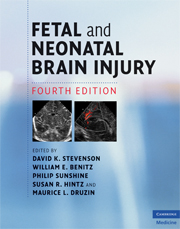Book contents
- Frontmatter
- Contents
- List of contributors
- Foreword
- Preface
- Section 1 Epidemiology, pathophysiology, and pathogenesis of fetal and neonatal brain injury
- Section 2 Pregnancy, labor, and delivery complications causing brain injury
- Section 3 Diagnosis of the infant with brain injury
- Section 4 Specific conditions associated with fetal and neonatal brain injury
- 22 Congenital malformations of the brain
- 23 Neurogenetic disorders of the brain
- 24 Hemorrhagic lesions of the central nervous system
- 25 Neonatal stroke
- 26 Hypoglycemia in the neonate
- 27 Hyperbilirubinemia and kernicterus
- 28 Polycythemia and fetal–maternal bleeding
- 29 Hydrops fetalis
- 30 Bacterial sepsis in the neonate
- 31 Neonatal bacterial meningitis
- 32 Neurological sequelae of congenital perinatal infection
- 33 Perinatal human immunodeficiency virus infection
- 34 Inborn errors of metabolism with features of hypoxic–ischemic encephalopathy
- 35 Acidosis and alkalosis
- 36 Meconium staining and the meconium aspiration syndrome
- 37 Persistent pulmonary hypertension of the newborn
- 38 Pediatric cardiac surgery: relevance to fetal and neonatal brain injury
- Section 5 Management of the depressed or neurologically dysfunctional neonate
- Section 6 Assessing outcome of the brain-injured infant
- Index
- Plate section
- References
32 - Neurological sequelae of congenital perinatal infection
from Section 4 - Specific conditions associated with fetal and neonatal brain injury
Published online by Cambridge University Press: 12 January 2010
- Frontmatter
- Contents
- List of contributors
- Foreword
- Preface
- Section 1 Epidemiology, pathophysiology, and pathogenesis of fetal and neonatal brain injury
- Section 2 Pregnancy, labor, and delivery complications causing brain injury
- Section 3 Diagnosis of the infant with brain injury
- Section 4 Specific conditions associated with fetal and neonatal brain injury
- 22 Congenital malformations of the brain
- 23 Neurogenetic disorders of the brain
- 24 Hemorrhagic lesions of the central nervous system
- 25 Neonatal stroke
- 26 Hypoglycemia in the neonate
- 27 Hyperbilirubinemia and kernicterus
- 28 Polycythemia and fetal–maternal bleeding
- 29 Hydrops fetalis
- 30 Bacterial sepsis in the neonate
- 31 Neonatal bacterial meningitis
- 32 Neurological sequelae of congenital perinatal infection
- 33 Perinatal human immunodeficiency virus infection
- 34 Inborn errors of metabolism with features of hypoxic–ischemic encephalopathy
- 35 Acidosis and alkalosis
- 36 Meconium staining and the meconium aspiration syndrome
- 37 Persistent pulmonary hypertension of the newborn
- 38 Pediatric cardiac surgery: relevance to fetal and neonatal brain injury
- Section 5 Management of the depressed or neurologically dysfunctional neonate
- Section 6 Assessing outcome of the brain-injured infant
- Index
- Plate section
- References
Summary
Introduction
Maternal infections, contracted during pregnancy, may be without fetal consequence or they may have serious adverse effects on the fetus. These adverse effects may include fetal death, stillbirth, intrauterine growth restriction, or congenital infection. Congenitally infected neonates may be symptomatic or asymptomatic at birth. Those who are symptomatic at birth generally have significant long-term sequelae. Those who are asymptomatic at birth may never manifest evidence of damage or they may develop clinically evident sequelae later in life. The overwhelming morbidity attributable to congenital infections is borne by this latter group.
The following chapter will discuss the neurologic consequences of congenital infections. The specific infectious agents that will be discussed are often referred to as the TORCH agents: T represents the parasite Toxoplasma gondii; O represents other agents such as varicella-zoster virus (VZV), human immunodeficiency virus (HIV), and Treponema pallidum (syphilis); R represents rubella virus; C represents cytomegalovirus (CMV); and H represents herpes simplex virus (HSV). With the exception of HSV, the major clinical impact of these agents results from exposure in utero. Morbidity and mortality attributable to neonatal HSV infection usually result from infection contracted at delivery.
Perinatal HIV infection is discussed in Chapter 33.
- Type
- Chapter
- Information
- Fetal and Neonatal Brain Injury , pp. 361 - 377Publisher: Cambridge University PressPrint publication year: 2009

